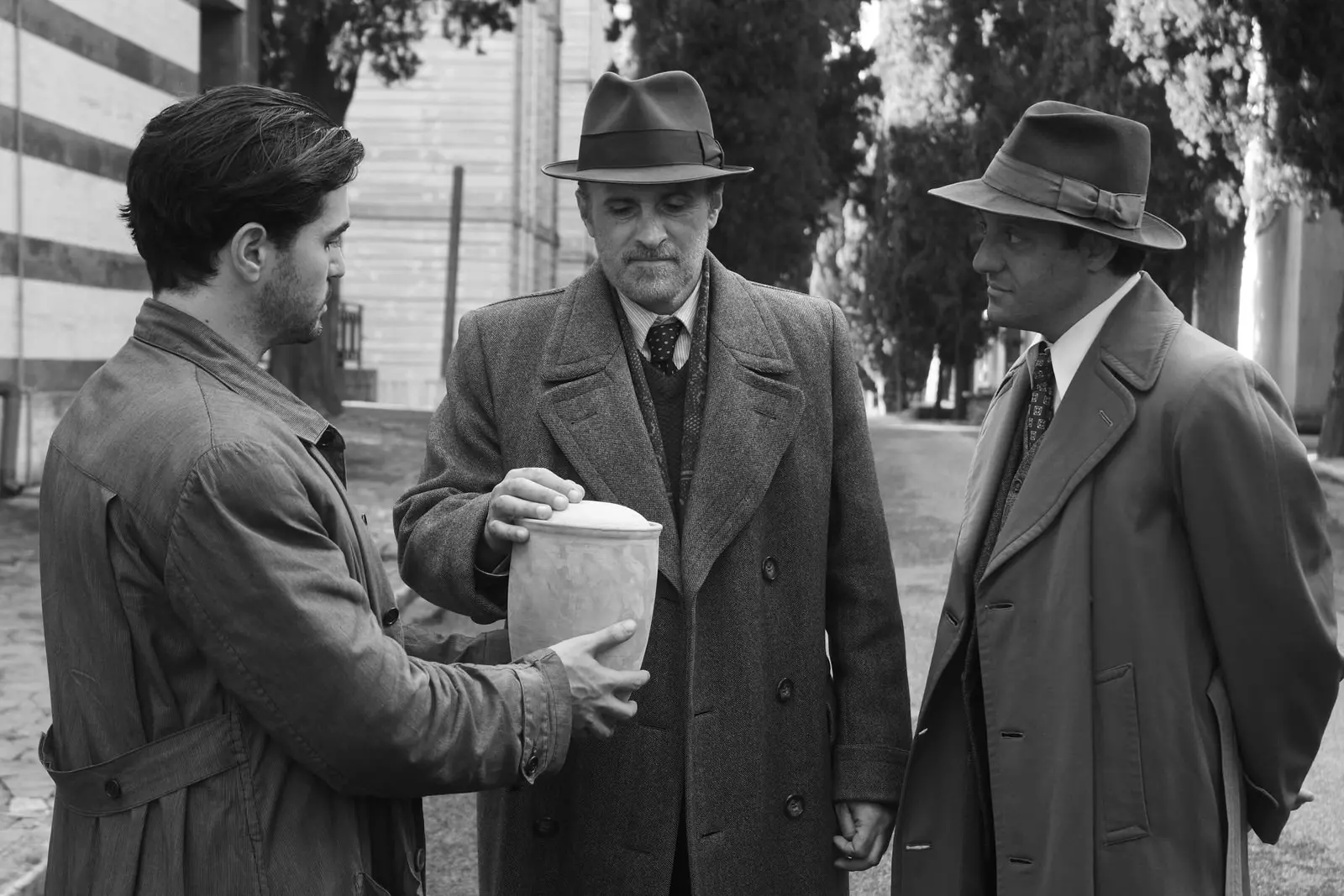
We use cookies
We use cookies and other tracking technologies to improve your browsing experience on our website, to show you personalized content and targeted ads, to analyze our website traffic, and to understand where our visitors are coming from.

On his deathbed in 1936, two years after receiving the Nobel Prize, Luigi Pirandello saw his life pass before him and his children age as they gradually approach his bedside, arranged in a white, antiseptic room at Cinecittà studios.
Leonora addio, whose title recalls Verdi’s Trovatore, describes the crazy adventure of the ashes of the famous writer and playwright, winner of the Nobel Prize for Literature in 1934. A story so incredible, it would seem inspired by his own writing if it hadn’t taken place after his death.
Pirandello left precise arrangements in his will: “Let my death pass in silence. My friends, my enemies, please do not speak of it to the newspapers, not even a mention. No announcements or notices. I will not be dressed when I am dead. I want to be wrapped naked in a sheet. No flowers on the bed and no lighting of candles. The simplest of funeral carriages, the poorest. Naked. No one is to come with me, not family nor friends. The carriage, the horse, the coachman is all. Burn me. And when my body is burnt, let it be scattered because I want nothing, not even ash to be left of me. If this cannot be, then take the urn to Sicily and wall it into a rough stone in the countryside of Girgenti where I was born”.
However, as the director Paolo Taviani recounts, events went in a different direction.
The fate of his ashes was decided by Palazzo Venezia and kept in Rome by war and Fascism. They were kept beneath a slab in the cemetery of Verano for ten long years, evoked by fragments of neorealism overlapping with scenes in the film, before a journey across post-war Italy takes them to his birthplace. While the countryside of Apulia, the white houses of Ostuni, olive groves of Fasano and salt flats of Margherita di Savoia, flash past outside the train windows, inside hope grows for a better future.
Travelling by train, the writer’s ashes arrive after being taken from the urn where they had been kept, placed in a trunk under the anxious and vigilant eyes of the representative of Agrigento (Fabrizio Ferracane), after a jolting journey across the cobbles of via Appia Antica by jeep and a failed attempt to catch a flight (the interior of the aircraft was shot in the Museo dell’Aeronautica in Bracciano) that never took off because of absurd superstition.
Reaching Sicily is not the end of the adventure: the ashes then cross the city inside a child’s coffin and await the slow construction of a mausoleum before finally finding peace 15 years after the writer’s death. In Sicily, the production shot in the streets of Ortigia, in Syracuse, inside the Benedictine Monastery and “Ursino Recupero" Library inCatania, in contrada Caos in Agrigento (location of the monument to Pirandello and his birthplace), and the castle of Palma di Montechiaro, where some of the ashes were scattered. The scenes where the sculptor finds the stone to build the mausoleum were shot in Argimusco, near the megaliths in the municipality of Montalbano Elicona.
Once the internment adventure is complete, the scene changes setting and scenario completely. Black and white footage becomes colour and a jump in time and space leads from post-war Italy to Brooklyn in the early 1900s where The Nail, novella written by Pirandello 20 days before his death, is set.
The ending reminds the viewers, through a short-circuit evoked by a recurring theme in Pirandello’s poetry, that life itself is theatre, in this case the Opera House of Rome.
On his deathbed in 1936, two years after receiving the Nobel Prize, Luigi Pirandello saw his life pass before him and his children age as they gradually approach his bedside, arranged in a white, antiseptic room at Cinecittà studios.
Leonora addio, whose title recalls Verdi’s Trovatore, describes the crazy adventure of the ashes of the famous writer and playwright, winner of the Nobel Prize for Literature in 1934. A story so incredible, it would seem inspired by his own writing if it hadn’t taken place after his death.
Pirandello left precise arrangements in his will: “Let my death pass in silence. My friends, my enemies, please do not speak of it to the newspapers, not even a mention. No announcements or notices. I will not be dressed when I am dead. I want to be wrapped naked in a sheet. No flowers on the bed and no lighting of candles. The simplest of funeral carriages, the poorest. Naked. No one is to come with me, not family nor friends. The carriage, the horse, the coachman is all. Burn me. And when my body is burnt, let it be scattered because I want nothing, not even ash to be left of me. If this cannot be, then take the urn to Sicily and wall it into a rough stone in the countryside of Girgenti where I was born”.
However, as the director Paolo Taviani recounts, events went in a different direction.
The fate of his ashes was decided by Palazzo Venezia and kept in Rome by war and Fascism. They were kept beneath a slab in the cemetery of Verano for ten long years, evoked by fragments of neorealism overlapping with scenes in the film, before a journey across post-war Italy takes them to his birthplace. While the countryside of Apulia, the white houses of Ostuni, olive groves of Fasano and salt flats of Margherita di Savoia, flash past outside the train windows, inside hope grows for a better future.
Travelling by train, the writer’s ashes arrive after being taken from the urn where they had been kept, placed in a trunk under the anxious and vigilant eyes of the representative of Agrigento (Fabrizio Ferracane), after a jolting journey across the cobbles of via Appia Antica by jeep and a failed attempt to catch a flight (the interior of the aircraft was shot in the Museo dell’Aeronautica in Bracciano) that never took off because of absurd superstition.
Reaching Sicily is not the end of the adventure: the ashes then cross the city inside a child’s coffin and await the slow construction of a mausoleum before finally finding peace 15 years after the writer’s death. In Sicily, the production shot in the streets of Ortigia, in Syracuse, inside the Benedictine Monastery and “Ursino Recupero" Library inCatania, in contrada Caos in Agrigento (location of the monument to Pirandello and his birthplace), and the castle of Palma di Montechiaro, where some of the ashes were scattered. The scenes where the sculptor finds the stone to build the mausoleum were shot in Argimusco, near the megaliths in the municipality of Montalbano Elicona.
Once the internment adventure is complete, the scene changes setting and scenario completely. Black and white footage becomes colour and a jump in time and space leads from post-war Italy to Brooklyn in the early 1900s where The Nail, novella written by Pirandello 20 days before his death, is set.
The ending reminds the viewers, through a short-circuit evoked by a recurring theme in Pirandello’s poetry, that life itself is theatre, in this case the Opera House of Rome.

Stemal Entertainment, Rai Cinema, Luce Cinecittà, Cinemaundici,